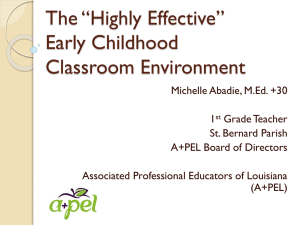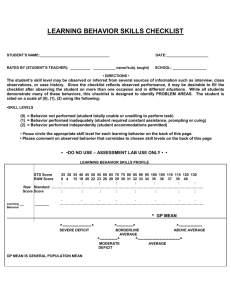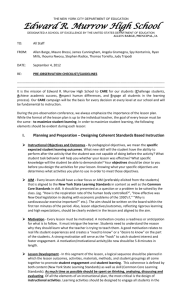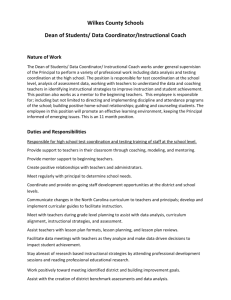The Teacher Skills Checklist – My Daemen
advertisement
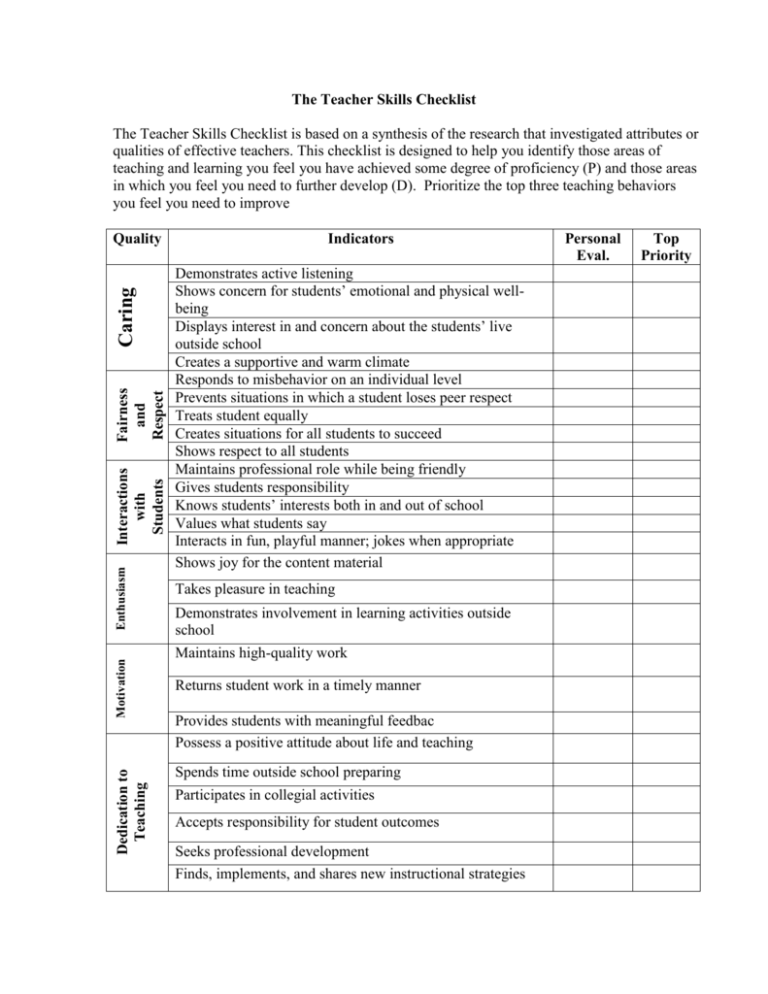
The Teacher Skills Checklist The Teacher Skills Checklist is based on a synthesis of the research that investigated attributes or qualities of effective teachers. This checklist is designed to help you identify those areas of teaching and learning you feel you have achieved some degree of proficiency (P) and those areas in which you feel you need to further develop (D). Prioritize the top three teaching behaviors you feel you need to improve Dedication to Teaching Motivation Enthusiasm Interactions with Students Fairness and Respect Caring Quality Indicators Demonstrates active listening Shows concern for students’ emotional and physical wellbeing Displays interest in and concern about the students’ live outside school Creates a supportive and warm climate Responds to misbehavior on an individual level Prevents situations in which a student loses peer respect Treats student equally Creates situations for all students to succeed Shows respect to all students Maintains professional role while being friendly Gives students responsibility Knows students’ interests both in and out of school Values what students say Interacts in fun, playful manner; jokes when appropriate Shows joy for the content material Takes pleasure in teaching Demonstrates involvement in learning activities outside school Maintains high-quality work Returns student work in a timely manner Provides students with meaningful feedbac Possess a positive attitude about life and teaching Spends time outside school preparing Participates in collegial activities Accepts responsibility for student outcomes Seeks professional development Finds, implements, and shares new instructional strategies Personal Eval. Top Priority Reflective Practice Classroom Management Organization Disciplining Students Importance of Instruction Time Allocation Teacher Expectation Knows areas of personal strengths and weaknesses Uses reflection to improve teaching Sets high expectations for personal classroom performance Demonstrates high efficacy Uses consistent and proactive discipline Establishes routines for all daily tasks and needs Orchestrates smooth transitions and continuity of classroom momentum Balances variety and challenge in student activities Multitasks Is aware of all activities in the classroom Anticipates potential problems Uses space, proximity, or movement around the classroom for nearness to trouble spots and to encourage attention Handles routines tasks promptly, efficiently, and consistently Prepares materials in advance; ready to use Organizes classroom space efficiently Interprets and respond to inappropriate behavior promptly Implements rules of behavior fairly and consistently Reinforces and reiterates expectations for positive behavior Uses appropriate disciplinary measures Focuses classroom time on teaching and learning Links instruction to real-life situations of the students Follows a consistent schedule and maintains procedures and routines Handles administrative tasks quickly and efficiently Prepares materials in advance Maintains momentum within and across lessons Limits disruption and interruptions Sets clearly articulated high expectations for self and students Orients the classroom experience toward improvement and growth Instruction Plans Instructiona l Strategies Content and Expectations Complexity Questioning Student Engagement Homework Stresses student responsibility and accountability Carefully links learning objectives and activities Organizes content for effective presentations Explores student understanding by asking questions Considers student attention spans and learning styles when designing instruction Develops objectives, questions, and activities that reflect higher and lower level cognitive skills as appropriate for the content and the students Employs different techniques and instructional strategies, such as hands-on learning Stresses meaningful conceptualization, emphasizing the student’s own knowledge of the world Sets overall high expectations toward improvement and growth in the classroom Gives clear examples and offers guided practice Stresses student responsibility and accountability in meeting expectations Teaches metacognitive strategies to support reflection on learning progress Is concerned with having students learn and demonstrate understanding of meaning rather than memorization Holds reading as a priority Stresses meaningful conceptualization, emphasizing the student’s knowledge of the world Emphasizes higher order thinking skills in math Questioning reflects type of content, goals of lesson Varies question type to maintain interest and momentum Prepares questions in advance Uses wait time during questioning Attentive to lesson momentum, appropriate questioning, clarity of explanation Varies instructional strategies, types of assignments, and activities Leads, directs, and paces student activities Clearly explains homework Relates homework to the content under study and to student capacity Grades, comments on, and discusses homework in class Monitoring Student Progress Targets questions to lesson objectives Thinks through likely misconceptions that may occur during instruction and monitors students for these misconceptions Gives clear, specific, and timely feedback Re-teaches students who did not achieve mastery and offers tutoring to students who seek additional help Responding to Student Needs and Abilities Suits instruction to students’ achievement levels and needs Participates in staff development training Uses a variety of grouping strategies Monitors and assesses student progress Knows and understands students as individuals in terms of ability, achievement, learning styles and needs


